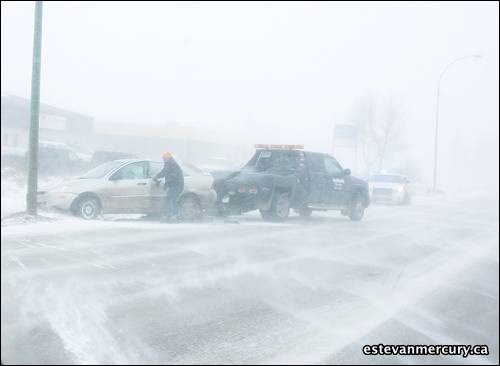The day began with relatively clear skies, light winds and moderate temperatures but by mid-morning last Friday, residents and visitors to southeast Saskatchewan found themselves in the midst of a good-old typical Saskatchewan blizzard.
The fierce winds, dropping temperatures and falling snow combined to reduce driving conditions to whiteout status where travel on local highways was not recommended.
Nowhere was the problem more evident than in Midale, the mid-way town between Estevan and Weyburn on Highway 39.
A local state-of-emergency was declared in that community as vehicles became stacked up on the side of the highway while others ended up blocking the entrances to the town of about 600 people.
Five or six members of the local First Responders team, who were still in the town made their way to the highway to rescue people from their vehicles and offer them a safe haven in the local arena until the storm passed.
"I believe the local responders received their first call around 11 a.m.," said Linda Dugan, the town's secretary who put in a long day co-ordinating the emergency relief system, and setting up a response centre in the arena.
At one point there were about 80 stranded motorists in the arena while many local residents were billeting other drivers or visitors to the town who were unable to make it back to their respective homes. In total, Dugan suggested there could have been as many as 200 people taking advantage of the Midale hospitality offer, but since those being put up in local homes weren't required to register anywhere, there would be no way of knowing the exact number.
By 9:30 that night, the storm conditions had eased enough to allow the travellers to leave the rink and the response centre was officially closed around 10 p.m.
Although some travellers remained in the community overnight, they didn't have to be registered and weren't required to remain in the rink.
The community response to the dilemma was terrific, said Dugan. Some young curlers from the Macoun School were already in the rink, so they stayed there and were joined by the stranded drivers. Soon sandwiches and soup were coming out of the arena's concession area along with its regular menu items.
"We were never in any danger of running out of food," Dugan said with a laugh.
A call that went out in the community for pillows and blankets, in the event that some people were going to have to spend the night there, prompted a huge response.
"I had a couple of volunteers ready to go out and collect them, but people just started showing up with blankets and pillows," said Dugan.
"I was surprised the highway was never declared officially closed, but all the agencies were stating travel wasn't recommended," Dugan added. The public safety commissioner suggested the declaration of a local emergency situation around 4 o'clock, she said.
Dugan added she was concerned about the safety of the local rescue team, but the day's event unfolded with no major incidents. One traveller ended up with a broken leg and an ambulance had to be dispatched to retrieve him, but all the others were brought in from the highway while those drivers who decided to drive on, were warned to exercise extreme caution.
One Estevan resident who made his way from Regina to the Energy City that day reported that it took him six hours to make what is usually a two-hour journey. This was due to the poor visibility that made him slow to 25 km/h on some stretches.
"The response was overwhelming and the emergency response people went well beyond the usual call of duty. It was a long 11 hours for them," said Dugan, who added that seven cars created the first traffic pileup near the town's intersection with Highway 39, which in turn, led to the original response. The accident scene couldn't be cleared properly until the incident had been investigated properly, so that led to more vehicles having to stop near or on the curve leading into Midale. There were up to a dozen disabled vehicles at one point, not including those that had made their way into the town but then required mechanical or cable boosts to get them going again a few hours later.
Dugan said she figured some people were stranded on the highway for between two and three hours before responders could get to them, but when the storm subsided, everything turned out fine.
The Estevan detachment of the RCMP reported that it was a very busy day and night for them with several reports of vehicles sliding off the highway and a few vehicle rollovers too, due to road conditions that deteriorated due to ice buildup in the afternoon and evening. The poor driving conditions even prevalent right within the city which prompted a six vehicle pileup along Kensington Avenue in the heart of the city's industrial/commercial subdivision.




